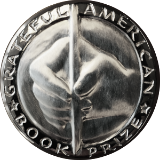Hidden Figures author Shetterly says history ‘cultivates not just young readers, but also the next generation of engaged citizens.’
WASHINGTON, DC, Nov 14 – Award-winning Hidden Figures author Margot Lee Shetterly didn’t start out as a history buff. But her book, a number one New York Times bestseller, revealed an innate passion for history and a knack for telling compelling stories about the events that have shaped our country– and our lives.
Her most recent accolade was the 2017 Grateful American Book Prize for her true tale about the early days of NASA. During the 1950s and 1960s, the Agency hired African American mathematicians to be human “computers” at its facility in Hampton, VA. But they were given menial positions as pencil pushers, a fate they overcame at a time when the inequities of racism was rampant. Hidden Figures shows that the women whose stories Shetterly reveals, proved they were as capable, and maybe even more so–than the next man–for the task of catapulting the first astronauts into outer space.
Hidden Figures is an excellent example of how “humanizing” the facts of history can be whipped into a context that young readers appreciate.
“I’ve always been a big reader, though as a kid I gravitated towards fiction,” Shetterly said. “Over time I came to enjoy epic histories. Working as an investment banker, I spent a lot of time reading financial histories, such as Ron Chernow’s biography, The House of Morgan. I started to read more general histories as a way of filling in the blanks in my knowledge, and doing so helped me to see the links between my own life and the past. Now, history is far and away my favorite genre.”
Shetterly believes history should remain a requirement for young learners. “But, we need to present it as more than just a dusty old broom closet; history is about learning true stories, and reliving the lives of fascinating people.
“And, the Prize has done a lot to resurrect an interest among young learners in the topic,” she said. “Planting the seed of interest in history when kids are young is a way to create a lifelong interest in the topic. And, I think the focus of the Grateful American Prize cultivates not just young readers, but also the next generation of engaged citizens.”
No one can deny that Shetterly has a way with words. As she puts it: “If you give people a choice between castor oil and cupcakes, they’ll probably choose cupcakes. History as taught in the classroom can be dense, dull, and seem irrelevant to students’ lives. What if we decided to teach it as if we were telling stories around a campfire?”
She doesn’t dismiss the importance of discipline in the classroom. She agrees: the study of history should be rigorous and require knowledge about dates, names, and places.
“We only have to look at the ‘Hamilton’ sensation to see how presenting the same information in a different format can have a galvanizing effect. Storytelling is an innately human activity, and remembering the “story” in “history” may be the first step. I also believe telling stories from a variety of points of view brings more readers into the fold, and gives us a broader understanding of America as a country and a culture.”
The Grateful American Book Prize was designed to give kids a way to learn about the events and personalities that figure large in the origins and development of our nation. It was created as an inducement for authors and their publishers to focus on authentic works of historical fiction and nonfiction that capture the imaginations and interests of young learners.
Shetterly asserts that reading a good story is a delight, and it’s “a particularly powerful thing to discover if the story that so captivated your imagination is also true. History is often taught by leading with dry facts and dates, but we need to heed the words of writer David McCullough: history is all about people. I’m encouraged by the early evidence that interest in history degrees increased sharply in the last year.”
Perhaps the 21st Century focus on science and technology can co-exist with the more introspective study of history in our classrooms.
In fact, Shetterly professes that STEM subjects [science, technology, engineering and mathematics] and the humanities are not necessarily diametrically opposed. “The work of the best scientists and engineers is amplified through clear prose, and the ability to communicate their findings and analysis. Writers are well served by having a degree of mathematical literacy, and the abilities to employ rational analysis and critical thinking. We need writers and scholars who have a knowledge of the history of science and technology. We need scientists with an understanding of the ways in which science and technology have provoked change in our society. I think one approach to improving performance and interest might be to teach history as a required component of STEM subject fields.”




